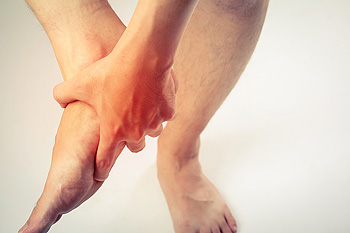Easing the Pain of Plantar Fasciitis
Monday, 10 February 2020 00:00 The connective tissue at the bottom of your foot that joins the heel bone to the toes and aids in arch support is referred to as the plantar fascia. If this tissue becomes strained, it may experience small tearing which can cause heel pain, as well as make it difficult to walk or stand. The plantar fascia is also likely to become inflamed when overstretched. This condition is known as plantar fasciitis. To help ease the discomfort and pain of this condition, it is suggested that you get plenty of rest off your feet, and reduce activity level throughout your day. Icing the affected area may also help in reducing inflammation and swelling. Try freezing a water bottle, and once frozen, roll the bottle under your foot to ice the entire plantar fascia. To help make the plantar fascia more flexible, it’s suggested to perform light calf exercises. If you are experiencing intense heel pain, and the affected area is warm, red, or causing a fever, it is recommended that you consult with a podiatrist as soon as possible for the best treatment options.
The connective tissue at the bottom of your foot that joins the heel bone to the toes and aids in arch support is referred to as the plantar fascia. If this tissue becomes strained, it may experience small tearing which can cause heel pain, as well as make it difficult to walk or stand. The plantar fascia is also likely to become inflamed when overstretched. This condition is known as plantar fasciitis. To help ease the discomfort and pain of this condition, it is suggested that you get plenty of rest off your feet, and reduce activity level throughout your day. Icing the affected area may also help in reducing inflammation and swelling. Try freezing a water bottle, and once frozen, roll the bottle under your foot to ice the entire plantar fascia. To help make the plantar fascia more flexible, it’s suggested to perform light calf exercises. If you are experiencing intense heel pain, and the affected area is warm, red, or causing a fever, it is recommended that you consult with a podiatrist as soon as possible for the best treatment options.
Plantar fasciitis is a common foot condition that is often caused by a strain injury. If you are experiencing heel pain or symptoms of plantar fasciitis, contact Dr. Steven Schwartz from Pennsylvania. Our doctor can provide the care you need to keep you pain-free and on your feet.
What Is Plantar Fasciitis?
Plantar fasciitis is one of the most common causes of heel pain. The plantar fascia is a ligament that connects your heel to the front of your foot. When this ligament becomes inflamed, plantar fasciitis is the result. If you have plantar fasciitis you will have a stabbing pain that usually occurs with your first steps in the morning. As the day progresses and you walk around more, this pain will start to disappear, but it will return after long periods of standing or sitting.
What Causes Plantar Fasciitis?
- Excessive running
- Having high arches in your feet
- Other foot issues such as flat feet
- Pregnancy (due to the sudden weight gain)
- Being on your feet very often
There are some risk factors that may make you more likely to develop plantar fasciitis compared to others. The condition most commonly affects adults between the ages of 40 and 60. It also tends to affect people who are obese because the extra pounds result in extra stress being placed on the plantar fascia.
Prevention
- Take good care of your feet – Wear shoes that have good arch support and heel cushioning.
- Maintain a healthy weight
- If you are a runner, alternate running with other sports that won’t cause heel pain
There are a variety of treatment options available for plantar fasciitis along with the pain that accompanies it. Additionally, physical therapy is a very important component in the treatment process. It is important that you meet with your podiatrist to determine which treatment option is best for you.
If you have any questions, please feel free to contact our offices located in Chambersburg, and Mcconnellsburg, PA . We offer the newest diagnostic and treatment technologies for all your foot care needs.

